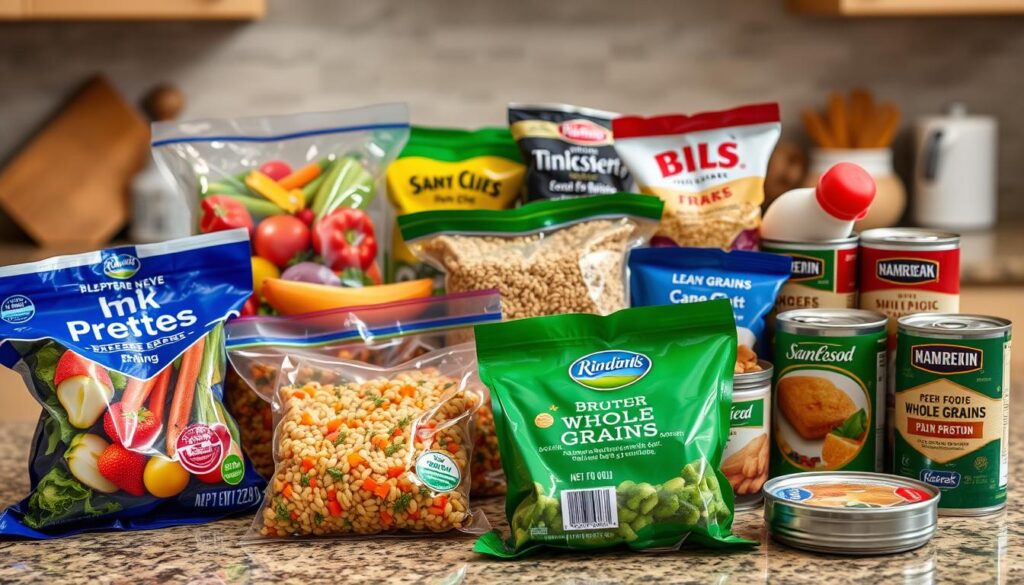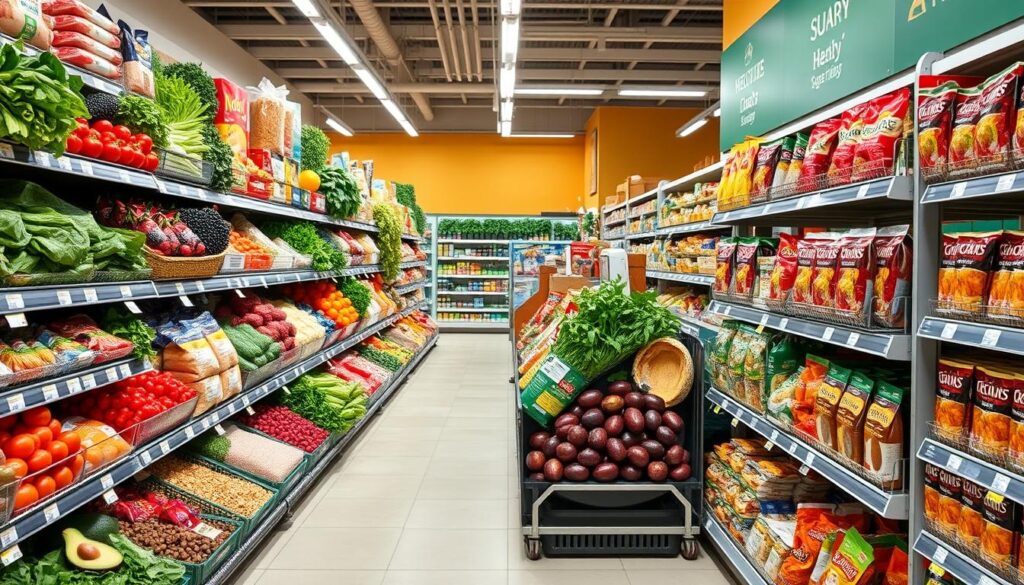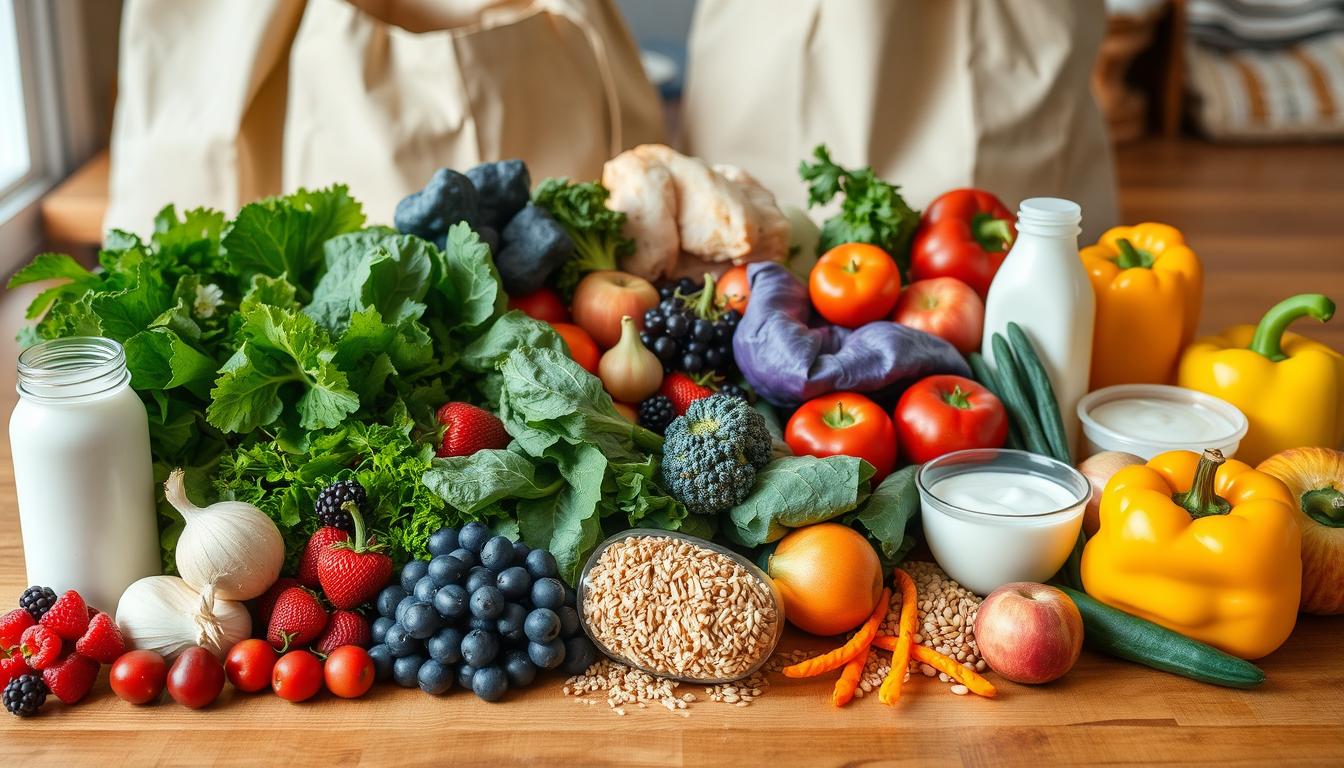Create a diabetic-friendly grocery list is one of the most important steps in managing blood sugar levels and improving your overall health. Shopping for the right foods ensures you avoid spikes in blood sugar while enjoying nutrient-dense meals. In this article, we’ll guide you through seven essential tips to help you choose the best foods for your health journey. Plus, you’ll learn what to buy, what to avoid, and how to make grocery shopping easier.
Key Takeaways (Placed After Introduction)
- Creating a diabetic-friendly grocery list helps you focus on nutrient-dense foods like lean proteins, whole grains, and vegetables.
- Avoid processed snacks, sugary drinks, and refined carbs to manage blood sugar effectively.
- Plan your meals in advance to stay on track with a balanced, diabetes-friendly diet.
- Read nutrition labels to spot hidden sugars and track carbs, fiber, and protein content.
Why Meal Planning is Key to Diabetes Management
Meal planning is a big help for people with diabetes. It only takes a few hours each week to plan your meals. This way, you can stick to a healthy diet, even when you’re busy.
Experts say to set aside time, like the weekend, to plan your meals. This includes making a menu and a grocery list.
Planning Your Meals Ahead of Time
Having a meal plan helps you make better food choices. It also helps control your blood sugar. After a few weeks, you’ll have a list of recipes you like.
Using online meal planning sites or apps can make it faster. This saves you time.
Meal planning is a powerful tool for diabetes management. Taking just a few hours each week to plan your meals allows you to maintain a healthy diet, even when you’re short on time. Experts recommend setting aside time on weekends to create a menu and grocery list.
By planning your meals ahead, you make healthier food choices that stabilize your blood sugar. Online meal planning tools or apps can also simplify the process and save you time. For more meal planning tips, check out our article on Easy Diabetic-Friendly Lunches
Best Foods for a Diabetic-Friendly Grocery List
A well-organized grocery list is essential for managing diabetes. Here’s a breakdown of the best foods to include and what to avoid:
1. Non-Starchy Vegetables:
Focus on leafy greens, broccoli, cauliflower, and zucchini. These low-carb options are packed with fiber and nutrients, helping to keep blood sugar stable.
2. Lean Proteins:
Choose chicken, turkey, fish, eggs, tofu, and legumes. These protein-rich foods help you feel full and regulate your blood sugar.
3. Whole Grains:
Opt for whole wheat bread, brown rice, quinoa, and oats. Whole grains are high in fiber and have a lower glycemic index compared to refined carbs.
4. Healthy Fats:
Include avocados, nuts, seeds, and olive oil in your diet. These fats improve insulin sensitivity and support heart health. For a more comprehensive guide to diabetes-friendly foods, visit the American Diabetes Association.
Fruits and Vegetables for a Diabetic-Friendly Diet
Fruits and vegetables are key for a diabetic-friendly diet. Non-starchy veggies like broccoli and leafy greens are low in calories and carbs. They’re perfect for those with diabetes. For fruits, it’s best to have just one serving per meal, like half a banana.
Frozen and in-season produce can save money. It’s important to pick a variety of colorful fruits and veggies. This ensures you get all the nutrients you need. The CDC’s 2020 report shows 34 million Americans have diabetes. A balanced diet, rich in fruits and vegetables, is vital for managing these conditions.
- Non-starchy veggies like broccoli are low in carbs and calories, great for diabetes.
- Experts say have just one serving of fruit per meal, like half a banana.
- Frozen and in-season produce are budget-friendly options.
- Choosing colorful fruits and vegetables ensures you get all the nutrients.
| Recommended Fruits for Diabetes | Recommended Vegetables for Diabetes |
|---|---|
| Berries, apples, oranges, bananas | Broccoli, cauliflower, leafy greens, zucchini |
| High in fiber and nutrients, with a lower glycemic index | Low in carbs and calories, high in fiber and nutrients |
Adding a variety of fruits and vegetables to your diet helps manage blood sugar. It also supports overall health for those with diabetes.
Lean Proteins: Meat, Seafood, and Plant-Based Options
Protein is key for managing diabetes. It doesn’t raise blood sugar levels much. So, it’s great for a diabetic diet. You can choose from lean meats, seafood, and plant-based proteins.
Choosing Lean Cuts of Meat and Poultry
Chicken, turkey, and pork are good for diabetes. They have less fat and more protein. This means they give energy without raising blood sugar.
Look for loin or round cuts. They are leaner than other parts of the animal.
Incorporating Seafood for Heart Health
Fatty fish like salmon, mackerel, and sardines are full of omega-3 fatty acids. These fats are good for the heart. Eating seafood twice a week is recommended.
You can grill, bake, or add it to salads and stir-fries. It’s tasty and good for diabetes.
Plant-Based Protein Sources
- Beans, lentils, and tofu are great plant-based protein sources. They also have fiber and complex carbs, which help with diabetes.
- Adding these plant-based options to your diet makes your protein intake more varied. You get a range of nutrients.
Choosing lean protein sources from meat, seafood, or plant-based options helps. It makes a balanced and diabetes-friendly diet. This supports your health and well-being.
Legumes: A Powerhouse of Fiber and Plant Protein
Legumes, like beans, peas, and lentils, are great for a diabetic-friendly diet. They are full of fiber and plant-based protein. This makes them a better choice than other starches. Try to eat at least one to two servings of legumes every day for their health benefits.
Legumes have a low glycemic index. This means they digest slowly, preventing blood sugar spikes. For example, a ½-cup of canned chickpeas has about 132 calories, 7 grams of protein, 20 grams of carbs, 9 grams of fat, and 7 grams of fiber.
Legumes are also packed with complex carbohydrates. One cup of shelled edamame has around 188 calories, 18 grams of protein, 13 grams of carbs, and 8 grams of dietary fiber. Adding legumes to your meals can make your diet more varied, nutritious, and satisfying, while keeping your blood sugar stable.
| Legume | Calories | Protein (g) | Carbs (g) | Fiber (g) |
|---|---|---|---|---|
| Chickpeas (1/2 cup) | 132 | 7 | 20 | 7 |
| Chia Seeds (1 tbsp) | 70 | 3 | 5 | 5 |
| Edamame (1 cup) | 188 | 18 | 13 | 8 |
Looking to manage diabetes, keep a healthy weight, or just nourish your body? Adding more legumes to your diet is a tasty and easy way to get their fiber and plant-based protein benefits.
Dairy and Dairy Alternatives
Dairy products are good for a diabetic diet because they have protein and calcium. But, picking the right ones is key to managing blood sugar.
Low-fat and Unsweetened Dairy Options
Low-fat or skim milk, plain Greek yogurt, and cottage cheese are good for diabetics. They have fewer calories, saturated fat, and sugars. This makes them better for a diabetic-friendly diet.
Nondairy Milk and Yogurt Alternatives
If you like dairy alternatives, try unsweetened soy milk, almond milk, and coconut yogurt. They have less sugar and can offer protein and calcium like dairy. They also don’t raise blood sugar as much.
Always check the labels of dairy or dairy alternatives you choose. Look for ones with fewer calories, added sugars, and saturated fat. This helps keep blood sugar in check and aids in managing diabetes.
Frozen and Canned Foods for Convenience
Managing diabetes can be easier with quick meal options. Frozen and canned foods are both affordable and healthy. They make it simple to stick to your health goals without spending too much time in the kitchen.
Frozen fruits and veggies are perfect for diabetics. You can find blueberries, blackberries, raspberries, and strawberries in the freezer. They’re full of fiber, which helps control blood sugar. Frozen veggies like peppers, broccoli, and spinach are also great. They’re easy to cook and keep their nutrients.
Canned foods are also good for your pantry. Choose ones without added sugars or too much salt. Canned fruits in juice and low-sodium veggies are good choices. Canned chickpeas, tomatoes, and salmon add protein and fiber to your meals.
Mixing frozen and canned foods makes meal planning simple. For example, you can whip up a stir-fry with frozen veggies, canned chicken, and quinoa. Or, blend frozen berries with protein powder and milk for a tasty breakfast.
Using frozen and canned foods saves time and reduces waste. They help make sure your meals are both tasty and healthy.

“Frozen and canned foods can be a game-changer for people with diabetes who are looking for quick, easy, and nutritious meal options.”
Smarter Snacking Options for Diabetes
Snacking can be tough for people with diabetes. But, there are many healthy options that can curb cravings without raising blood sugar. By choosing wisely, you can snack in a way that helps manage your diabetes and keeps you healthy.
It’s smart to pick snacks rich in fiber, protein, or healthy fats. These nutrients slow down carb absorption, keeping blood sugar stable. Here are some good snack choices:
- Nuts and seeds
- Carrots and celery with hummus
- Plain Greek yogurt
- Fresh fruit paired with a protein or healthy fat, such as an apple with peanut butter
Controlling portion sizes is key when snacking for diabetes. Use measuring cups and spoons to avoid too many carbs at once. Also, eat mindfully to avoid overeating.
When you shop for snacks, head to the grocery store’s perimeter. That’s where you’ll find whole, unprocessed foods. Avoid the middle aisles, which often have snacks high in added sugars, sodium, and unhealthy fats. These can harm blood sugar control.
By following these tips, you can enjoy tasty snacks that support your health and diabetes management.
Whole Grains: A Better Choice for Blood Sugar Control
Managing diabetes means watching what carbs you eat. Whole grains are better than refined grains for people with diabetes. They have fiber, protein, and nutrients that help control blood sugar and give lasting energy.
Refined grains like white bread and rice lose their good stuff when processed. This makes them easy to digest, causing blood sugar to jump up fast. But whole grains, like whole wheat and brown rice, keep more of their fiber and nutrients.
- Whole grains have a lower glycemic index, meaning they don’t cause blood sugar to rise as quickly.
- The fiber in whole grains slows the absorption of carbohydrates, helping to maintain steady energy levels and prevent blood sugar crashes.
- Whole grains are also a good source of magnesium, a mineral that plays a crucial role in insulin sensitivity and glucose metabolism.
To add more whole grains to your diet, try these swaps:
- Whole wheat bread or pasta
- Brown rice or quinoa
- Oats or barley
- Buckwheat or millet
Adding healthy fats and proteins with whole grains can also help control blood sugar. Switching to whole grains can help manage diabetes and improve overall health.
“Whole grains are a powerhouse of nutrients that can help regulate blood sugar levels and support overall health for individuals with diabetes.”
How to Create a Diabetic-Friendly Grocery List: What to Buy and What to Avoid
Shopping for groceries can be tough for people with diabetes. But, making a smart shopping list can really help. Focus on buying foods that are good for you and help control your blood sugar.
Start with non-starchy veggies. They’re full of vitamins, minerals, and fiber. Choose leafy greens, cruciferous veggies, and colorful fruits and veggies. Fruits are okay in small amounts, but watch their sugar content.
- Include lean proteins like chicken, turkey, fish, tofu, tempeh, and legumes. They keep you full and help keep your blood sugar stable.
- Choose whole grains like quinoa, brown rice, and whole wheat bread. They’re high in fiber and don’t raise blood sugar as much as refined grains do.
- Get healthy fats from avocados, nuts, seeds, and olive oil. They help with insulin sensitivity and reduce inflammation.
Avoid processed snacks, sugary drinks, and refined carbs. They can cause blood sugar to spike. Read labels carefully to avoid hidden sugars and carbs. Choose low-sugar, low-carb options when you can.
| What to Buy | What to Avoid |
|---|---|
|
|
Being smart about your grocery list can help you stock up on healthy foods. This supports your health and diabetes management. A balanced diet is crucial for managing diabetes well.

Reading Nutrition Labels for Diabetes Management
For people with diabetes, reading nutrition labels is key. Look at the serving size, total carbs, and added sugars. Don’t forget about fiber, as it helps slow down carb absorption.
Watch out for hidden sugars in foods. They might be called corn syrup, fructose, or dextrose. Learning to read labels helps you choose better foods when you shop.
Understanding the Nutrition Facts Label
The “Nutrition Facts” label shows info on fat, cholesterol, sodium, carbs, protein, vitamins, and minerals. It tells you the nutrient content and calories in a serving. The “% Daily Value” shows how much of your daily needs are in a serving, based on a 2,000 calorie diet.
Identifying Hidden Sources of Sugar
Labels might say “low cholesterol,” “low fat,” or “reduced sugar.” These claims have specific meanings based on serving size. Always check the serving size, as it affects how much you eat.
Artificial sweeteners like sucralose, acesulfame potassium, and aspartame hide sugars. Opt for foods with more fiber, less sugar, and sodium to manage diabetes or prediabetes.
“As of January 2021, food labels must include added sugar information to differentiate between natural sugars and added sugars in processed foods.”
| Nutrient | Daily Recommendation |
|---|---|
| Fiber | 25-38 grams |
| Sodium | 2,300 milligrams or less |
Sample Diabetic-Friendly Grocery List
Making a good grocery list is key to managing diabetes. Fill your cart with foods that are full of nutrients but low in sugar. This helps control your blood sugar and keeps you healthy. Here’s a sample list to help you shop:
- Vegetables: broccoli, cauliflower, spinach, kale, carrots, zucchini, bell peppers
- Fruits: apples, berries, citrus fruits, melons
- Lean proteins: chicken, turkey, fish, eggs, tofu, beans, lentils
- Dairy: low-fat or skim milk, plain Greek yogurt, cottage cheese
- Whole grains: whole wheat bread, brown rice, quinoa, oats
- Healthy fats: avocado, nuts, olive oil
- Condiments: vinegar, spices, herbs, mustard, salsa
This list is a great start for making healthy meals and snacks. Tailor it to fit your taste and dietary needs. Eating whole, unprocessed foods helps manage your diabetes and boosts your health.
For a good grocery list for diabetes, focus on healthy foods with less sugar and more fiber, protein, and fats. A bit of meal planning can lead to a balanced diet. This keeps your blood sugar levels stable.
Conclusion
Creating a diabetes-friendly grocery list is key to managing diabetes through healthy eating. Focus on foods like non-starchy veggies, fruits, lean proteins, whole grains, and healthy fats. These help control blood sugar levels.
Good meal planning, reading labels, and watching portion sizes are also important. The American Diabetes Association suggests eating half your plate with non-starchy veggies. They also recommend certain fruits like apples, apricots, bananas, blueberries, and kiwi for stable blood sugar.
With smart grocery shopping and healthier choices, people with diabetes can manage their condition better. They can improve their health and well-being. By following the tips in this article, they can make a nutrition plan that fits their needs and preferences. This empowers them to live a healthier, more fulfilling life.

